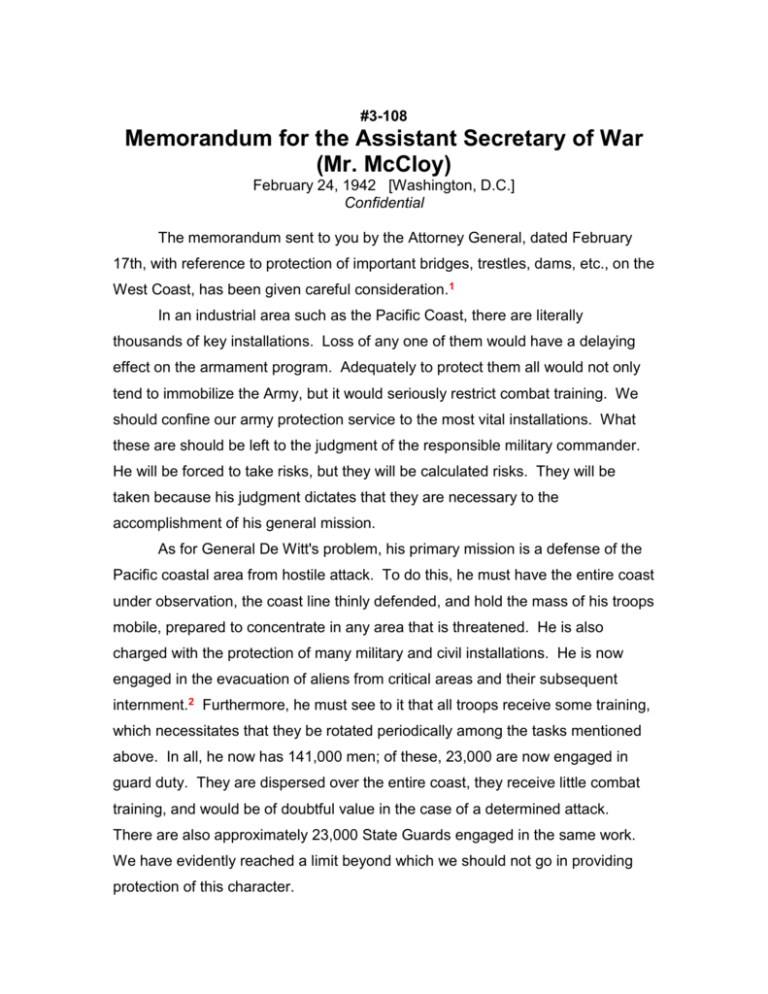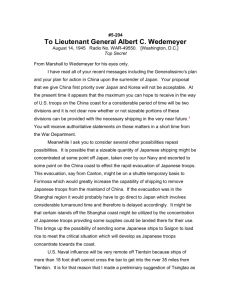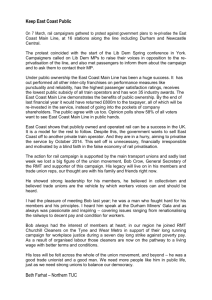3-108 - George C. Marshall Foundation
advertisement

#3-108 Memorandum for the Assistant Secretary of War (Mr. McCloy) February 24, 1942 [Washington, D.C.] Confidential The memorandum sent to you by the Attorney General, dated February 17th, with reference to protection of important bridges, trestles, dams, etc., on the West Coast, has been given careful consideration.1 In an industrial area such as the Pacific Coast, there are literally thousands of key installations. Loss of any one of them would have a delaying effect on the armament program. Adequately to protect them all would not only tend to immobilize the Army, but it would seriously restrict combat training. We should confine our army protection service to the most vital installations. What these are should be left to the judgment of the responsible military commander. He will be forced to take risks, but they will be calculated risks. They will be taken because his judgment dictates that they are necessary to the accomplishment of his general mission. As for General De Witt's problem, his primary mission is a defense of the Pacific coastal area from hostile attack. To do this, he must have the entire coast under observation, the coast line thinly defended, and hold the mass of his troops mobile, prepared to concentrate in any area that is threatened. He is also charged with the protection of many military and civil installations. He is now engaged in the evacuation of aliens from critical areas and their subsequent internment.2 Furthermore, he must see to it that all troops receive some training, which necessitates that they be rotated periodically among the tasks mentioned above. In all, he now has 141,000 men; of these, 23,000 are now engaged in guard duty. They are dispersed over the entire coast, they receive little combat training, and would be of doubtful value in the case of a determined attack. There are also approximately 23,000 State Guards engaged in the same work. We have evidently reached a limit beyond which we should not go in providing protection of this character. Guarding of utilities, industrial plants, railroads, bridges, and similar installations will be the subject of increasing pressure on the War Department. In most cases the necessary protection should be provided by the corporation, the individual owner, the municipality, or the state. Only exceptionally should federal troops be used. If we yield from this position we will soon have most of our armed forces on such duty and as a result they will be ineffective for combat. We may also develop a defensive psychology in our people by fostering a desire for strong local protection, rather than for a mobile army prepared to carry the fighting to the enemy. Worst of all, we would be playing directly into the hands of the Axis powers. I am convinced that we should impress upon the public that our primary task is to defeat the enemy by a concentrated offensive effort rather than by the passive defense of every crossroad. The people should know that sporadic hostile raids are to be expected, and that when such raids occur, some damage will result despite our protective measures. They should know that there will be some sabotage despite all the precautions we may take. But they should be brought to feel that we should not swerve from our great objective, to defeat the enemy, by dispersing our forces on guard duty in answer to every frantic call. They should be brought to realize that the enemy will plan raids or threats for no other purpose than to immobilize our planes, boats or troops. I hesitate to forward the Attorney General's letter to General De Witt. If I do, he cannot help but feel that it contains a measure of censure. It would be only human for him to think that for his own protection he must now detach additional troops for the purposes suggested. My recommendation is that you reply to the Attorney General in the vein indicated above. I will forward to General De Witt a copy of the Attorney General's letter to you, with a copy of this memorandum. Document Copy Text Source: Records of the War Department General and Special Staffs (RG 165), Records of the Office of the Chief of Staff (OCS), 15450–15, National Archives and Records Administration, College Park, Maryland. Document Format: Typed memorandum. 1. Francis Biddle, attorney general of the United States, had written that he had received numerous reports indicating "that all is not being done which seems advisable in the matter of protection" of various strategic installations; for example, the Boca Dam in California's Donner Pass area was poorly guarded, and the airport at Reno, Nevada, was "entirely without guards." (Biddle to McCloy, February 17, 1942, NA/RG 165 [OCS, 15450–15].) 2. Theater commander John L. De Witt had initially opposed evacuating all JapaneseAmericans from the West Coast, but by mid-February he had concluded that it was necessary—especially in view of intensifying prejudice and violence against JapaneseAmericans and of growing pressure for evacuation from West Coast political leaders. The decision to evacuate and intern the more than 110,000 persons in this ethnic group was reached and planning begun during the first half of February 1942; President Roosevelt issued the necessary Executive Order 9066 on February 19. Coordination of the program by the War Department was primarily the responsibility of Assistant Secretary of War John J. McCloy. Apparently Marshall neither took part in nor was he informed of specific developments in the program during the first half of February. (Conn, Engelman, and Fairchild, Guarding the United States and Its Outposts, pp. 117–39; on Marshall's lack of involvement see notes 45 and 68. De Witt's published report on the project is Western Defense Command, Final Report: Japanese Evacuation from the West Coast, 1942 [Washington: GPO, 1943].) Recommended Citation: The Papers of George Catlett Marshall, ed. Larry I. Bland and Sharon Ritenour Stevens (Lexington, Va.: The George C. Marshall Foundation, 1981– ). Electronic version based on The Papers of George Catlett Marshall, vol. 3, “The Right Man for the Job,” December 7, 1941–May 31, 1943 (Baltimore and London: The Johns Hopkins University Press, 1991), pp. 109–111.










